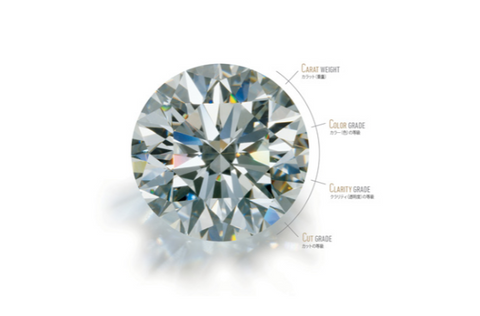THE FOUR C'S

The Four C's
Diamonds come in all shapes, sizes, and colors. They can be treated, cut, and polished to take on new looks, but the underlying quality remains the same. When you buy a diamond from Q & T Jewelry, you know that you are buying a sparkling, eye-catching diamond of exceptional quality and value. Jewelers often refer to the Four C’s of Diamonds, which are described below. Our jewelers will guide you through the selection process, discussing each of the Four C’s with you and making sure that the diamond you take home is one that you will love forever.
The First C: Cut
Cut is widely considered to be the most important contributing factor to the brilliance of a diamond. Although cut is often misinterpreted as a diamond’s shape, it actually refers to the proportions and finish of the diamond.
Cut is graded on a scale that ranges from Excellent to Poor. The diamond’s rating on this scale is determined by the diamond’s brightness, fire, scintillation, weight ratio, polish, and symmetry.
Generally speaking, a diamond should not be cut too shallow or too deep—the perfect cut will bring out maximum light return and sparkle inherent in each stone. Most importantly, the quality of the cut can mask other diamond characteristics. It is important to remember that color, clarity, and even carat weight are determined mainly by Mother Nature. However, cut is a factor determined and engineered by man to maximize brilliance and sparkle.
The Second C: Color
The next 'C,' is Color. Color is one of the major components of the 4 C’s. It is important to know the basics about diamond color grading before deciding what color diamond to buy. When it comes to the color grade of the diamond it actually refers to the LACK of color.
The scale is divided into 23 shades with the color scale beginning at D and ending at Z. Diamonds with complete absence of color (D-E-F) are rare and the most expensive. Nearly colorless diamonds (G-H-I-J) offer the best value if you are looking to make most of your budget. You save money in color and can spend more on an excellent cut that will give it more brilliance in your diamond. Ranges K-L-M come under a faint yellow or brown range, meaning they will have a slight tint that is visible to naked eye. Choosing this grade can get you a significantly bigger diamond for less money. At the end of the day, you must decide what characteristics matter more to you in finding the “perfect” diamond.
The Third C: Clarity
Following after color is the third ‘C,’ clarity. To understand diamond clarity, we must understand how diamonds are created. Natural diamonds are the result of carbon being exposed to tremendous heat and pressure deep inside of the earth. The result of the process leads to internal characteristics called "inclusion" and external characteristics called “blemishes.” Diamond clarity involves the overall appearance of the stone, but remember there is no perfectly pure diamond.
The diamond clarity scale has six categories that are divided with a total of 11 specific grades:
- Flawless (FL): No inclusions or blemishes visible under 10x magnification
- Internally Flawless (IF): No inclusions visible under 10x magnification
- Very, Very Slightly Included (VVS1 and VVS2): Inclusions so slight they are difficult for a skilled grader to see under 10x magnification
- Very Slightly Included (VS1 and VS2): Inclusions are observed with effort under 10x magnification, but can be characterized as minor
- Slightly Included (SI1 and SI2): Inclusions are noticeable under 10x magnification
- Included (I1, I2, and I3): Inclusions are obvious under 10x magnification which may affect transparency and brilliance
Many inclusions and blemishes are too tiny to be seen by anyone other than a trained diamond grader. To the naked eye, VS1 and SI2 diamonds may look exactly the same but are different in the terms of overall quality. Knowing what diamond clarity means can help you understand the factors that contribute to a diamond’s quality and price.
The Fourth C: Carat
And lastly, we come to the final ‘C’ when choosing your diamond, carat. In simple terms, ‘carat’ is the unit measurement to specified the weight of a diamond; not the size of the diamond. Although it is related to size, two diamond shapes with the same carat weight can look very different. For example, a 1.00 carat cushion diamond would look small compared to a 1.00 carat oval, as ovals are an elongated shape. If you want to make your engagement ring look bigger you can opt for a certain diamond shape that can give off a bigger look by their carat weight.
In conclusion, these are the four C’s that you must think about when choosing the perfect diamond for your engagement ring. If you are still unsure for what exactly what it is what you are looking for in a diamond, we will help guide you through the choosing process and help you understand what exactly you are looking for and give you exact quality and trust you deserve.
